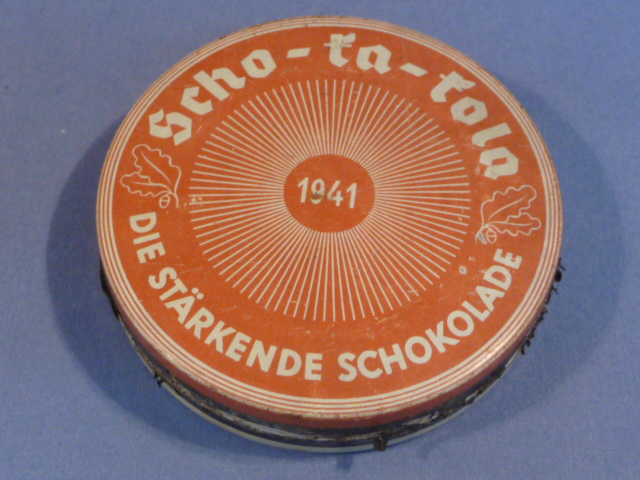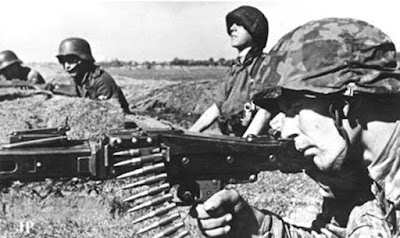Scho-Ka-Kola (for Scho kolade – Ka ffee – Kola nuss) was created in 1935 and patented by the Hildebrand, Kakao- und Schokoladenfabrik manufacturer, established by chocolatier Theodor Hildebrand (1791-1854) in Alt-Berlin.
It was introduced at the 1936 Summer Olympics as a performance-enhancing energy "Sport Chocolate" (German Sportschokolade). It was also produced by the chocolate manufacturer B. Sprengel & Co. in Hannover, who in 1936 was recognized as an important pre-war economy operation, as well as produced by other German chocolate manufacturers.
 In World War II, Scho-Ka-Kola was colloquially known as the "Aviator Chocolate" (German Fliegerschokolade), as it was commonly provided with Luftwaffe pilot and crew rations, to induce or extend wakefulness and alertness , especially on night-bombing missions, and was also issued to flight-crews in blue canisters as emergency sea-survival rations (German Seenotpackung).
In World War II, Scho-Ka-Kola was colloquially known as the "Aviator Chocolate" (German Fliegerschokolade), as it was commonly provided with Luftwaffe pilot and crew rations, to induce or extend wakefulness and alertness , especially on night-bombing missions, and was also issued to flight-crews in blue canisters as emergency sea-survival rations (German Seenotpackung).Original retail canister in 1941, scho-ka-kola printed in lowercase Fraktur calligraphy.
Scho-Ka-Kola was also issued during World War II to German tank crews, as well as German U-boat crews and the German Army. During the occupation period it was also distributed to the German population by the Allies. German Wehrmacht -issue World War II Scho-Ka-Kola tin containers are highly sought after by collectors.
 Scho-Ka-Kola is mentioned three times in Johann Voss's World War II autobiography, Black Edelweiss. "Johann Voss", real name unknown, joins the Waffen-SS in 1943 at only 17. He ends up in Northern Finland as an SS mountain ranger, and participates in heavy fighting against the Russians. When things go particularly bad, round tin boxes of Scho-Ka-Kola are issued to the troops. He also claims that during the Battle of the Bulge (particularly, the town of Reipertsweiler, in which Voss participated in a German victory), Scho-Ka-Kola was given to captured American troops as an act of respect for their bravery. Voss details Scho-Ka-Kola in the footnotes, calling the chocolate "pure luxury" and explains that each round tin contains two discs of dark chocolate, laced with caffeine from coffee beans.
Scho-Ka-Kola is mentioned three times in Johann Voss's World War II autobiography, Black Edelweiss. "Johann Voss", real name unknown, joins the Waffen-SS in 1943 at only 17. He ends up in Northern Finland as an SS mountain ranger, and participates in heavy fighting against the Russians. When things go particularly bad, round tin boxes of Scho-Ka-Kola are issued to the troops. He also claims that during the Battle of the Bulge (particularly, the town of Reipertsweiler, in which Voss participated in a German victory), Scho-Ka-Kola was given to captured American troops as an act of respect for their bravery. Voss details Scho-Ka-Kola in the footnotes, calling the chocolate "pure luxury" and explains that each round tin contains two discs of dark chocolate, laced with caffeine from coffee beans.In 1969 German chocolate producer Hans Imhoff took over the Hildebrand chocolate company, and in 1972 also bought the beleaguered Stollwerck chocolate manufacturer from Deutsche Bank for distribution. On July 1, 2005, the German Genuport company gained all brand and distribution rights to the product. Currently it is made by a subsidiary in Berlin and available across Germany and distributed in a limited number of foreign countries.























